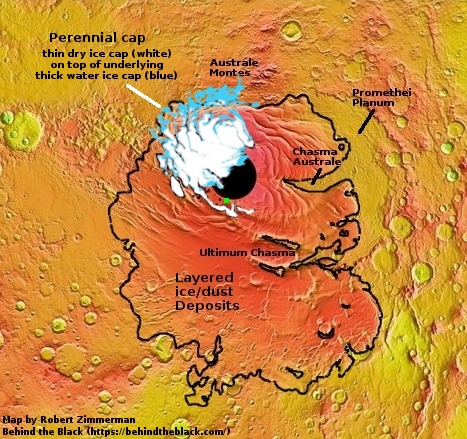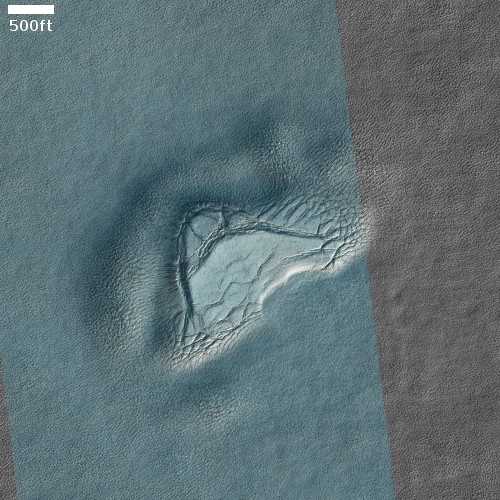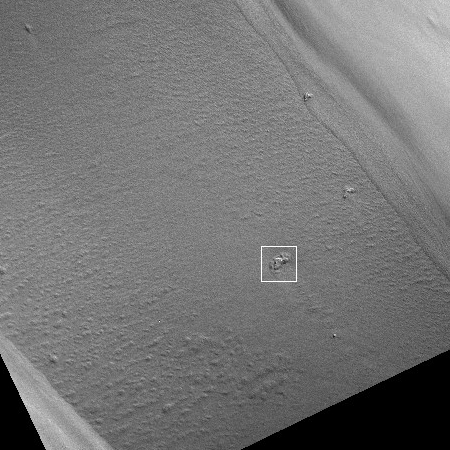A iceberg of water ice floating on a Martian dry ice sea
British biologist John Haldane once once wrote, “The universe is not only queerer than we suppose, but queerer than we can suppose.”
Today’s cool image to the right, cropped to post here, is a fine example of Haldane’s words. It was taken on January 15, 2021 by the high resolution camera on Mars Reconnaissance Orbiter of a single lone mesalike feature sticking up in a flat expanse of Mars’ south polar dry ice/water ice cap.
I emailed Shane Byrne of the Lunar and Planetary Lab University of Arizona, who had requested the photo, to ask him what he thinks we are looking at. His response:
This region has a thick layer of CO2 ice sandwiched between water ice that’s above and below. CO2 ice is denser than water ice so I think a fragment of water ice of the underlying layer has risen up through the denser CO2 ice that covers this area (what geologists call a diapir).
Byrne also admits this remains merely “just a wild theory,” not yet confirmed.
Assuming this theory to be right, in a sense then this mesa is not really a mesa at all but an iceberg of water, floating not in a saltwater liquid ocean as on Earth but on a frozen sea of dry ice. Talk about queer! The wider shot below, taken by MRO’s context camera, illustrates how isolated this water iceberg is on that dry ice sea.

The white box marks the area covered by the photo above, and shows how this bulging iceberg of water ice is one of only a handful on this wide expanse of flat dry ice. Even though the water ice below is lighter than the dry ice that covers it, in most cases the dry ice is structurally strong enough to hold that water ice down, with only a few breaks in its mantle.
For both images south it to the top. The two whiter areas to the northeast and southwest of the dry ice sea in the context photo are probably an additional seasonal layer of CO2, deposited during the winter and now sublimating away because it is now summer. You can see a third small mesa that has broken through the permanent dry ice cap as well as the seasonal dry ice mantle to the northeast.
The overview map to the right gives the larger context. The green dot marks the location of this image. It is one of the closest to the pole that MRO has taken (though not the closest). Though the map suggests this picture is on the layered ice/debris deposits, not the perennial cap of dry ice on top of water ice, the map’s resolution is not that precise. This close to the pole there are plenty of patches of that perennial cap that extend past the marked areas shown on the map.
The reason that there is a black hole surrounding the pole is for engineering reasons. As Byrne explained,
The spacecraft orbit only goes up to latitudes of 87 degrees north and south. To see closer to the poles we roll to one side as we pass by. The maximum spacecraft roll we can do in normal operations is 30 degrees. At the north pole that’s enough for us to see all the way to the pole itself. At the south pole we don’t quite make it because the spacecraft and ground are closer together there.
Though there are some high resolution images inside that black hole, the engineering requirements limit the number. Today’s photo is right at the limit where no special engineering maneuvers are required.
On Christmas Eve 1968 three Americans became the first humans to visit another world. What they did to celebrate was unexpected and profound, and will be remembered throughout all human history. Genesis: the Story of Apollo 8, Robert Zimmerman's classic history of humanity's first journey to another world, tells that story, and it is now available as both an ebook and an audiobook, both with a foreword by Valerie Anders and a new introduction by Robert Zimmerman.
The print edition can be purchased at Amazon or from any other book seller. If you want an autographed copy the price is $60 for the hardback and $45 for the paperback, plus $8 shipping for each. Go here for purchasing details. The ebook is available everywhere for $5.99 (before discount) at amazon, or direct from my ebook publisher, ebookit. If you buy it from ebookit you don't support the big tech companies and the author gets a bigger cut much sooner.
The audiobook is also available at all these vendors, and is also free with a 30-day trial membership to Audible.
"Not simply about one mission, [Genesis] is also the history of America's quest for the moon... Zimmerman has done a masterful job of tying disparate events together into a solid account of one of America's greatest human triumphs."--San Antonio Express-News
British biologist John Haldane once once wrote, “The universe is not only queerer than we suppose, but queerer than we can suppose.”
Today’s cool image to the right, cropped to post here, is a fine example of Haldane’s words. It was taken on January 15, 2021 by the high resolution camera on Mars Reconnaissance Orbiter of a single lone mesalike feature sticking up in a flat expanse of Mars’ south polar dry ice/water ice cap.
I emailed Shane Byrne of the Lunar and Planetary Lab University of Arizona, who had requested the photo, to ask him what he thinks we are looking at. His response:
This region has a thick layer of CO2 ice sandwiched between water ice that’s above and below. CO2 ice is denser than water ice so I think a fragment of water ice of the underlying layer has risen up through the denser CO2 ice that covers this area (what geologists call a diapir).
Byrne also admits this remains merely “just a wild theory,” not yet confirmed.
Assuming this theory to be right, in a sense then this mesa is not really a mesa at all but an iceberg of water, floating not in a saltwater liquid ocean as on Earth but on a frozen sea of dry ice. Talk about queer! The wider shot below, taken by MRO’s context camera, illustrates how isolated this water iceberg is on that dry ice sea.

The white box marks the area covered by the photo above, and shows how this bulging iceberg of water ice is one of only a handful on this wide expanse of flat dry ice. Even though the water ice below is lighter than the dry ice that covers it, in most cases the dry ice is structurally strong enough to hold that water ice down, with only a few breaks in its mantle.
For both images south it to the top. The two whiter areas to the northeast and southwest of the dry ice sea in the context photo are probably an additional seasonal layer of CO2, deposited during the winter and now sublimating away because it is now summer. You can see a third small mesa that has broken through the permanent dry ice cap as well as the seasonal dry ice mantle to the northeast.
The overview map to the right gives the larger context. The green dot marks the location of this image. It is one of the closest to the pole that MRO has taken (though not the closest). Though the map suggests this picture is on the layered ice/debris deposits, not the perennial cap of dry ice on top of water ice, the map’s resolution is not that precise. This close to the pole there are plenty of patches of that perennial cap that extend past the marked areas shown on the map.
The reason that there is a black hole surrounding the pole is for engineering reasons. As Byrne explained,
The spacecraft orbit only goes up to latitudes of 87 degrees north and south. To see closer to the poles we roll to one side as we pass by. The maximum spacecraft roll we can do in normal operations is 30 degrees. At the north pole that’s enough for us to see all the way to the pole itself. At the south pole we don’t quite make it because the spacecraft and ground are closer together there.
Though there are some high resolution images inside that black hole, the engineering requirements limit the number. Today’s photo is right at the limit where no special engineering maneuvers are required.
On Christmas Eve 1968 three Americans became the first humans to visit another world. What they did to celebrate was unexpected and profound, and will be remembered throughout all human history. Genesis: the Story of Apollo 8, Robert Zimmerman's classic history of humanity's first journey to another world, tells that story, and it is now available as both an ebook and an audiobook, both with a foreword by Valerie Anders and a new introduction by Robert Zimmerman.
The print edition can be purchased at Amazon or from any other book seller. If you want an autographed copy the price is $60 for the hardback and $45 for the paperback, plus $8 shipping for each. Go here for purchasing details. The ebook is available everywhere for $5.99 (before discount) at amazon, or direct from my ebook publisher, ebookit. If you buy it from ebookit you don't support the big tech companies and the author gets a bigger cut much sooner.
The audiobook is also available at all these vendors, and is also free with a 30-day trial membership to Audible.
"Not simply about one mission, [Genesis] is also the history of America's quest for the moon... Zimmerman has done a masterful job of tying disparate events together into a solid account of one of America's greatest human triumphs."--San Antonio Express-News




Hi Bob,
Did you happen to ask Shane Byrne if there would be liquid CO2 under the solid CO2? Perhaps the heaven sheet of CO2 could provide enough pressure to allow the liquid state.
This would allow the migration of the water ice under the sheet in the liquid CO2.
Chris: I did not ask him that question, but there would not be any liquid CO2. It sublimates directly to a gas.
If there is any CO2 gas at the border between the water and CO2, it might act as a lubricant and allow things to shift. In this case however I am doubtful the iceberg can move at all, because it is locked in by solid dry ice.
Hi Bob
My question is could the condition for liquid state exist under the CO2 sheet due to the weight of the sheet. That weight would increase the pressure. If there is enough pressure the liquid state may exist.
Hm. Now that’s an interesting thought. I wonder. I’ll ask.